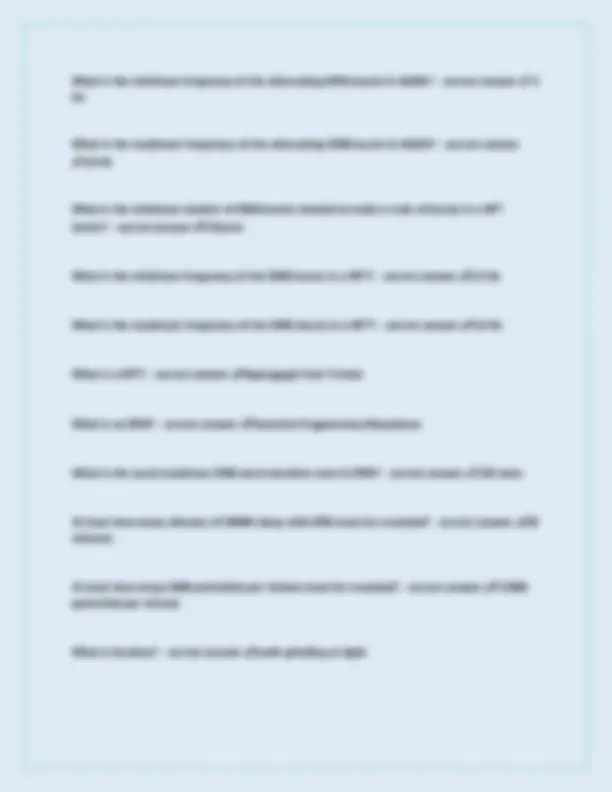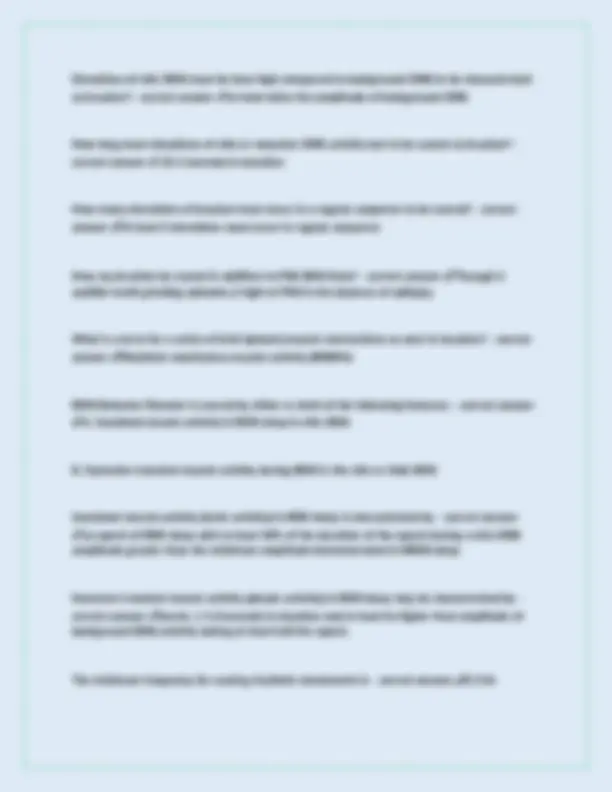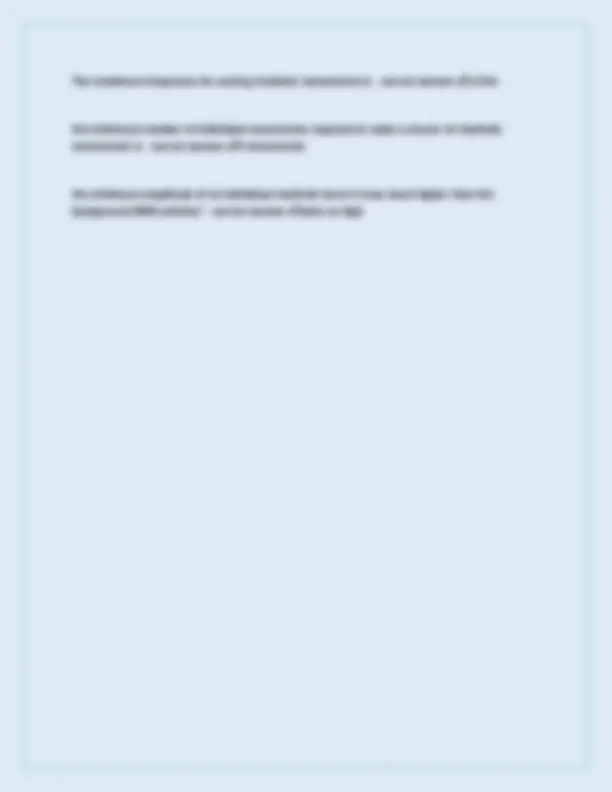





Study with the several resources on Docsity

Earn points by helping other students or get them with a premium plan


Prepare for your exams
Study with the several resources on Docsity

Earn points to download
Earn points by helping other students or get them with a premium plan
Community
Ask the community for help and clear up your study doubts
Discover the best universities in your country according to Docsity users
Free resources
Download our free guides on studying techniques, anxiety management strategies, and thesis advice from Docsity tutors
A comprehensive overview of movement disorders in sleep, focusing on key concepts and definitions relevant to the rpsgt exam. It covers various types of movements, including leg movements, bruxism, and rhythmic movements, and outlines the criteria for scoring these events during polysomnography (psg). The document also includes information on the placement of electrodes, impedance requirements, and the minimum duration and amplitude needed for scoring different types of movements.
Typology: Exams
1 / 5

This page cannot be seen from the preview
Don't miss anything!




⪛⪴⪴⪷⪱⪘ ⪞⪴⪸εΘΙΙμλΜιΙππππ ιΤΜΜτλμτΧ⪛⪴⪴⪷ ⪱⪘⪞⪴⪸ε ΘΙΙμλΜιΙππππ ιΤΜΜτλμτΧ
How far should leg electrodes be placed on the anterior tibialis? - correct answer ✔2-3 cm apart or 1/3 the length of the AT muscle
For monitoring leg movements, Impedances must be less than how many ohms? - correct answer ✔10,000 ohms
For detecing bruxism, additional electrodes may be placed where? - correct answer ✔on the masseter muscle
2 optional EMG placements for detecting TMA in REM sleep are - correct answer ✔The Flexor digitorum superficialis and the Extensor digitorum communis
For diagnosis of RBD, what is required? - correct answer ✔Audio-equipped video PSG
For diagnosis of RMD, what is required? - correct answer ✔video PSG
What is the minimum duration required to score a LM? - correct answer ✔.5 seconds
What is the maximum duration of an LM event? - correct answer ✔10 seconds
What is the minimum amplitude required for an LM? - correct answer ✔8 microvolt increase in chin EMG above resting
⪛⪴⪴⪷⪱⪘ ⪞⪴⪸εΘΙΙμλΜιΙππππ ιΤΜΜτλμτΧ⪛⪴⪴⪷ ⪱⪘⪞⪴⪸ε ΘΙΙμλΜιΙππππ ιΤΜΜτλμτΧ
What is the timing of the ending of a LM movement in terms of voltage of EMG? - correct answer ✔It must be .5 seconds of time where EMG does not exceed 2 microvolts resting duration
What is the minimum number of consecutive LM events needed to define a PLM series? - correct answer ✔ 4
The period length between LMs required to include them as part of a PLM series is - correct answer ✔5 to 90 seconds
If a leg movement is detected on 2 different legs, what is the duration of time necessary for them to be scored separately? - correct answer ✔greater than 5 seconds apart
What is the duration of time that an LM and an arousal are associated, regardless of whether or not the LM occurs before or after the arousal? - correct answer ✔.5 seconds
When should an LM not be scored in relation to a respiratory event? - correct answer ✔If it occurs .5 seconds before or after the event
When a period of wake lasting <90 seconds separates a series of LMs, do you still score them in series? - correct answer ✔Yes. If a leg movement that occurs in wake it will not be considered a PLM of sleep, but it can still contribute to a series.
What is the minimum number of discrete and alternating EMG bursts of leg muscle activity needed to score an ALMA series? - correct answer ✔ 4
What is an ALMA? - correct answer ✔Alternating Leg Muscle activation
What is the usual range for duration of an ALMA? - correct answer ✔100-500 msec
⪛⪴⪴⪷⪱⪘ ⪞⪴⪸εΘΙΙμλΜιΙππππ ιΤΜΜτλμτΧ⪛⪴⪴⪷ ⪱⪘⪞⪴⪸ε ΘΙΙμλΜιΙππππ ιΤΜΜτλμτΧ
Elevations of chin EMG must be how high compared to background EMG to be characterized as bruxism? - correct answer ✔at least twice the amplitude of background EMG
How long must elevations of chin or masseter EMG activity last to be scored as bruxism? - correct answer ✔.25-2 seconds in duration
How many elevations of bruxism must occur in a regular sequence to be scored? - correct answer ✔At least 3 elevations must occur in regular sequence
How my bruxism be scored in addition to PSG EMG Data? - correct answer ✔Through 2 audible tooth grinding episodes / night of PSG in the absence of epilepsy
What is a term for a series of brief (phasic) muscle contractions as seen in bruxism? - correct answer ✔Rhythmic masticatory muscle activity (RMMA)
REM Behavior DIsorder is scored by either or both of the following features: - correct answer ✔A. Sustained muscle activity in REM sleep in chin EMG
B. Excessive transient muscle activity during REM in the chin or limb EMG
Sustained muscle activity (tonic activity) in REM sleep is characterized by - correct answer ✔an epoch of REM sleep with at least 50% of the duration of the epoch having a chin EMG amplitude greater than the minimum amplitude demonstrated in NREM sleep
Excessive transient muscle activity (phasic activity) in REM sleep may be characterized by - correct answer ✔bursts .1-5.0 seconds in duration and at least 4x higher than amplitude of background EMG activity lasting at least half the epoch.
The minimum frequency for scoring rhythmic movements is - correct answer ✔0.5 Hz
⪛⪴⪴⪷⪱⪘ ⪞⪴⪸εΘΙΙμλΜιΙππππ ιΤΜΜτλμτΧ⪛⪴⪴⪷ ⪱⪘⪞⪴⪸ε ΘΙΙμλΜιΙππππ ιΤΜΜτλμτΧ
The maximum frequency for scoring rhythmic movements is - correct answer ✔2.0 Hz
the minimum number of individual movements required to make a cluster of rhythmic movements is - correct answer ✔4 movements
the minimum amplitude of an individual rhythmic burst is how much higher than the background EMG activity? - correct answer ✔twice as high